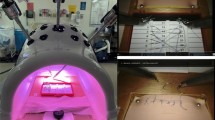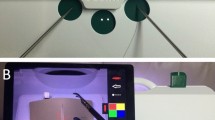Abstract
Background
We devised a new method incorporating cyber visual training whereby novices in endoscopic surgery are instructed via repetition of a video-recorded procedure. We then conducted a study designed to investigate the impact of this cyber visual training on the mastery of intracorporeal knot-tying as an endoscopic technique.
Methods
For the cyber visual training a 10-min video of the same procedure was replayed at normal, slow, and rapid speeds or presented in a series of still images. The training was undertaken by 36 medical students and 1st year trainee doctors who had had no experience of endoscopic surgery. They were divided into three groups, each of all received the same introductory lecture. Group A was only given training with the instructor for 15 min. Group B trained with the instructor for 15 min and was allowed self-training for 10 min. Group C viewed the cyber video beforehand and then underwent training with the instructor for 15 min. For all participants, the time required to complete a knot-tying task was measured and the level of endoscopic skill before and after the training was assessed using a virtual reality system the minimally Invasive Surgical Trainer–Virtual Reality (MIST - VR), in terms of the following three parameters: time, errors, and efficiency of hand movements. The Steel-Dwass test was used to evaluate the differences among the three groups in task performance.
Results
Group C completed the knot-tying task faster than group A (p = 0.0375), but there were significant differences between groups A and B and groups B and C. There were no significant differences in the parameters assessed using the MIST-VR.
Conclusions
Our new concept of cyber visual training is effective for mastering the knot-tying technique. This type of training should be widely applicable to other procedures, such as dissection, clipping, and hemostasis.



Similar content being viewed by others
Referenes
G Ahlberg T Heikkinen L Iselius CE Leijonmarck J Rutqvist D Arvidsson (2002) ArticleTitleDoes training in a virtual reality simulator improve surgical performance? Surg Endosc 16 126–129 Occurrence Handle10.1007/s00464-001-9025-6 Occurrence Handle11961622
FL Atienza I Balaguer ML Garcia-Merita (1998) ArticleTitleVideo modeling and imaging training on performance of tennis service of 9- to 12-year-old children Percept Mot Skills 87 519–529 Occurrence Handle9842596
AM Derossis J Bothwell HH Sigman GM Fried (1998) ArticleTitleThe effect of practice on performance in a laparoscopic simulator Surg Endosc 175 1117–1120 Occurrence Handle10.1007/s004649900796
AM Derossis GM Fried M Abrahamowicz HH Sigman JS Barkun JL Meakins (1998) ArticleTitleDevelopment of a model for training and evaluation of laparoscopic skills Am J Surg 175 482–487 Occurrence Handle10.1016/S0002-9610(98)00080-4 Occurrence Handle9645777
AM Derossis M Antoniuk GM Fried (1999) ArticleTitleEvaluation of laparoscopic skills: a 2-year follow-up during residency training Can J Surg 42 293–296 Occurrence Handle10459330
GM Fried AM Derossis J Bothwell HH Sigman (1999) ArticleTitleComparison of laparoscopic performance in vivo with performance measured in a laparoscopic simulator Surg Endosc 13 1077–1081 Occurrence Handle10.1007/s004649901176 Occurrence Handle10556441
TP Grantcharov J Rosenberg E Pahle P Funch-Jensen (2001) ArticleTitleVirtual reality computer simulation Surg Endosc 15 242–244 Occurrence Handle10.1007/s004640090008 Occurrence Handle11344422
TP Grantcharov L Bardram P Funch-Jensen J Rosenberg (2003) ArticleTitleLearning curves and impact of previous operative experience on performance on a virtual reality simulator to test laparoscopic surgical skills Am J Surg 185 146–149 Occurrence Handle10.1016/S0002-9610(02)01213-8 Occurrence Handle12559445
RS Haluck TM Krummel (2000) ArticleTitleComputers and virtual reality for surgical education in the 21st century Arch Surg 135 786–792 Occurrence Handle10.1001/archsurg.135.7.786 Occurrence Handle10896371
EC Hamilton DJ Scott JB Fleming RV Rege R Laycock PC Bergen ST Tesfay et al. (2002) ArticleTitleComparison of video trainer and virtual reality training systems on acquisition of laparoscopic skills Surg Endosc 16 406–411 Occurrence Handle10.1007/s00464-001-8149-z Occurrence Handle11928017
RR Horn AM Williams MA Scott (2002) ArticleTitleLearning from demonstrations: the role of visual search during observational learning from video and point-light models J Sports Sci 20 253–269 Occurrence Handle10.1080/026404102317284808 Occurrence Handle11999480
TB Hugh (2002) ArticleTitleNew strategies to prevent laparoscopic bile duct injury—surgeons can learn from pilots Surgery 132 826–835 Occurrence Handle10.1067/msy.2002.127681 Occurrence Handle12464867
SB Issenberg WC McGaghie IR Hart JW Mayer JM Felner ER Petrusa RA Waugh et al. (1999) ArticleTitleSimulation technology for health care professional skills training and assessment JAMA 74 861–866 Occurrence Handle10.1001/jama.282.9.861
JA Jordan AG Gallagher J McGuigan N McClure (2000) ArticleTitleRandomly alternating image presentation during laparoscopic training leads to faster automation to the “fulcrum effect.” Endoscopy 38 317–321 Occurrence Handle10.1055/s-2000-7374
JA Jordan AG Gallagher J McGuigan N McClure (2001) ArticleTitleVirtual reality training leads to faster adaptation to the novel psychomotor restrictions encountered by laparoscopic surgeons Surg Endosc 15 1080–1084 Occurrence Handle10.1007/s004640000374 Occurrence Handle11727074
AI Macmillan A Cuschieri (1999) ArticleTitleAssessment of innate ability and skills for endoscopic manipulations by the Advanced Dundee Endoscopic Psychomotor Tester: predictive and concurrent validity Am J Surg 177 274–277 Occurrence Handle10.1016/S0002-9610(99)00016-1 Occurrence Handle10219869
AM Pearson AG Gallagher JC Rosser RM Satava (2002) ArticleTitleEvaluation of structured and quantitative training methods for teaching intracorporeal knot tying Surg Endosc 16 130–137 Occurrence Handle10.1007/s00464-001-8113-y Occurrence Handle11961623
TE Piemme (1988) ArticleTitleComputer-assisted learning and evaluation in medicine JAMA 260 367–372 Occurrence Handle10.1001/jama.260.3.367 Occurrence Handle3288776
JC Rosser LE Rosser RS Savalgi (1997) ArticleTitleSkill acquisition and assessment for laparoscopic surgery Arch Surg 132 200–204 Occurrence Handle9041927
LA Scherer MC Chang JW Meredith FD Battistella (2003) ArticleTitleVideotape review leads to rapid and sustained learning Am J Surg 185 516–520 Occurrence Handle10.1016/S0002-9610(03)00062-X Occurrence Handle12781877
MP Schijven J Jakimowicz C Schot (2002) ArticleTitleThe Advanced Dundee Endoscopic Psychomotor Tester (ADEPT) objectifying subjective psychomotor test performance Surg Endosc 16 943–948 Occurrence Handle10.1007/s00464-001-9146-y Occurrence Handle12163960
DJ Scott PC Bergen RV Rege R Laycock ST Tesfay RJ Valentine DM Euhus et al. (2000) ArticleTitleLaparoscopic training on bench models better and more cost effective than operating room experience? J Am Coll Surg 191 272–283
J Torkington SG Smith B Rees A Darzi (2001) ArticleTitleThe role of the basic surgical skills course in the acquisition and retention of laparoscopic skill Surg Endosc 15 1071–1075 Occurrence Handle10.1007/s004640000183 Occurrence Handle11727072
Author information
Authors and Affiliations
Corresponding author
Additional information
This paper was presented at the annual meeting of the Society of American Gastrointestinal Endoscopic Surgions (SAGES), Denver, CO, USA, 31 March–3 April 2004
Rights and permissions
About this article
Cite this article
Takiguchi, S., Sekimoto, M., Yasui, M. et al. Cyber visual training as a new method for the mastery of endoscopic surgery. Surg Endosc 19, 1204–1210 (2005). https://doi.org/10.1007/s00464-004-8236-z
Received:
Accepted:
Published:
Issue Date:
DOI: https://doi.org/10.1007/s00464-004-8236-z




